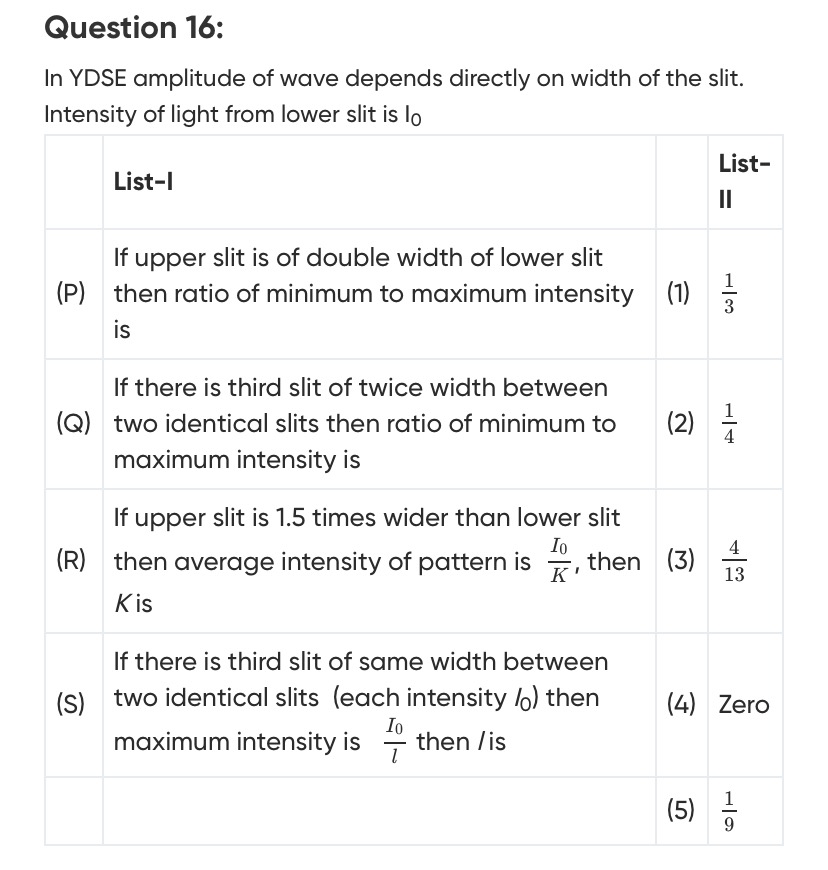Question
Question: In YDSE amplitude of wave depends directly on width of the slit. Intensity of light from lower slit ...
In YDSE amplitude of wave depends directly on width of the slit. Intensity of light from lower slit is l0
| List-I | List-II |
|---|---|
| (P) If upper slit is of double width of lower slit then ratio of minimum to maximum intensity is | (1) 31 |
| (Q) If there is third slit of twice width between two identical slits then ratio of minimum to maximum intensity is | (2) 41 |
| (R) If upper slit is 1.5 times wider than lower slit then average intensity of pattern is KI0, then K is | (3) 134 |
| (S) If there is third slit of same width between two identical slits (each intensity l0) then maximum intensity is lI0 then /is | (4) Zero |
| (5) 91 |

P-5, Q-4, R-3, S-5
P-1, Q-2, R-3, S-4
P-5, Q-1, R-2, S-3
P-4, Q-5, R-3, S-1
P-5, Q-4, R-3, S-5
Solution
The problem describes Young's Double Slit Experiment (YDSE) where the amplitude of the wave is directly proportional to the width of the slit. This implies that the intensity (I) is proportional to the square of the amplitude (A2), and thus proportional to the square of the slit width (w2). We can write I∝w2. Let I1 and I2 be the intensities from two slits with amplitudes A1 and A2. Then I1=A12 and I2=A22. If w1 and w2 are the widths, then A1=cw1 and A2=cw2, leading to I1=c2w12 and I2=c2w22. The ratio of intensities is I2I1=w22w12.
The intensity at any point in the interference pattern is given by I=I1+I2+2I1I2cosϕ, where ϕ is the phase difference. Maximum intensity (Imax) occurs when cosϕ=1, so Imax=I1+I2+2I1I2=(I1+I2)2=(A1+A2)2. Minimum intensity (Imin) occurs when cosϕ=−1, so Imin=I1+I2−2I1I2=(I1−I2)2=(A1−A2)2. The ratio of minimum to maximum intensity is ImaxImin=(I1+I2)2(I1−I2)2. The average intensity ⟨I⟩ for a two-slit experiment is ⟨I⟩=I1+I2, because the average value of cosϕ over a full cycle is zero.
We assume "Intensity of light from lower slit is I0" means that for one of the slits (say slit 1), I1=I0.
(P) If upper slit is of double width of lower slit: Let w1 be the width of the lower slit and w2 be the width of the upper slit. Given w2=2w1. Since I∝w2, I2=(w1w2)2I1=(w12w1)2I1=4I1. Given I1=I0, so I2=4I0. ImaxImin=(I0+4I0)2(I0−4I0)2=(I0+2I0)2(I0−2I0)2=(3I0)2(−I0)2=9I0I0=91. Thus, (P) matches with (5).
(Q) If there is third slit of twice width between two identical slits: This is a three-slit experiment. Let the slits be S1, S2, S3. Let S1 and S3 be identical, so w1=w3=w. Let their intensity be I1=I3=I. The third slit S2 has twice the width, w2=2w. Its intensity is I2=(w2w)2I=4I. Assuming I1=I0, then I3=I0 and I2=4I0. The corresponding amplitudes are A1=I0, A3=I0, and A2=4I0=2I0. For maximum intensity, all waves must be in phase. If the slits are equally spaced, this occurs at the central point. Amax=A1+A2+A3=I0+2I0+I0=4I0. Imax=(4I0)2=16I0. For minimum intensity, we consider the resultant amplitude Ares=A1+A2eiΔϕ+A3ei2Δϕ, where Δϕ is the phase difference between adjacent slits. Ares=I0+2I0eiΔϕ+I0ei2Δϕ=I0(1+2eiΔϕ+ei2Δϕ)=I0(1+eiΔϕ)2. The resultant amplitude is zero if 1+eiΔϕ=0, which means eiΔϕ=−1, or Δϕ=π. If Δϕ=π, then Ares=I0(1+(−1))2=0. Thus, the minimum intensity Imin=0. The ratio ImaxImin=16I00=0. Thus, (Q) matches with (4).
(R) If upper slit is 1.5 times wider than lower slit then average intensity of pattern is KI0: Let w1 be the width of the lower slit and w2 be the width of the upper slit. Given w2=1.5w1=23w1. Given I1=I0. I2=(w1w2)2I1=(w13/2w1)2I0=(23)2I0=49I0. The average intensity ⟨I⟩=I1+I2=I0+49I0=413I0. The question states ⟨I⟩=KI0. So, 413I0=KI0. K=134. Thus, (R) matches with (3).
(S) If there is third slit of same width between two identical slits (each intensity l0) then maximum intensity is lI0: This is a three-slit experiment. Let the slits be S1, S2, S3. S1 and S3 are identical with intensity I1=I3=I0. S2 is between them and has the same width, so w2=w1=w3. Thus I2=I1=I3=I0. The amplitudes are A1=I0, A2=I0, A3=I0. For maximum intensity, all waves are in phase (at the central maximum). Amax=A1+A2+A3=I0+I0+I0=3I0. Imax=(3I0)2=9I0. The question states Imax=lI0. So, 9I0=lI0. l=91. Thus, (S) matches with (5).
The correct matches are: (P) - (5) (Q) - (4) (R) - (3) (S) - (5)
